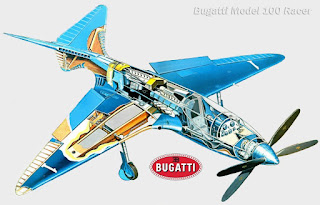History of Bugatti Part 3-Type 35... autosmithcar.com
The original model, introduced at the Grand Prix of Lyon on August 3, 1924, used an evolution of the three-valve 2.0 L (1991 cc/121 in³) overhead cam straight-eight engine first seen on the Type 29. Bore was 60 mm and stroke was 88 mm as on many previous Bugatti models. Ninety-six examples were produced.
This new powerplant featured five main bearings with an unusual ball bearing system. This allowed the engine to rev to 6,000 rpm, and 90 hp (67 kW) was reliably produced. Solid axles with leaf springs were used front and rear, and drum brakes at the back, operated by cables, were specified. Alloy wheels were a novelty, as was the hollow front axle for reduced unsprung weight. A second feature of the Type 35 that was to become a Bugatti trademark was passing the springs through the front axle rather than simply U-bolting them together as was done on their earlier cars.
A rare version was de-bored (to 52 mm) for a total displacement of 1.5 L (1494 cc/91 in³). There are two of these cars in New Zealand.
Dimensions:
- Length: 3680 mm (144.9 in)
- Width: 1320 mm (52 in)
- Wheelbase: 2400 mm (94.5 in)
- Track: 1200 mm (47.2 in)
- Weight: 750 kg (1650 lb)
The Bugatti made its name literally on the race tracks. After almost everything being lost during World War 1. Almost 100 years later we still equate fast cars with the name Bugatti.




Comments
Post a Comment